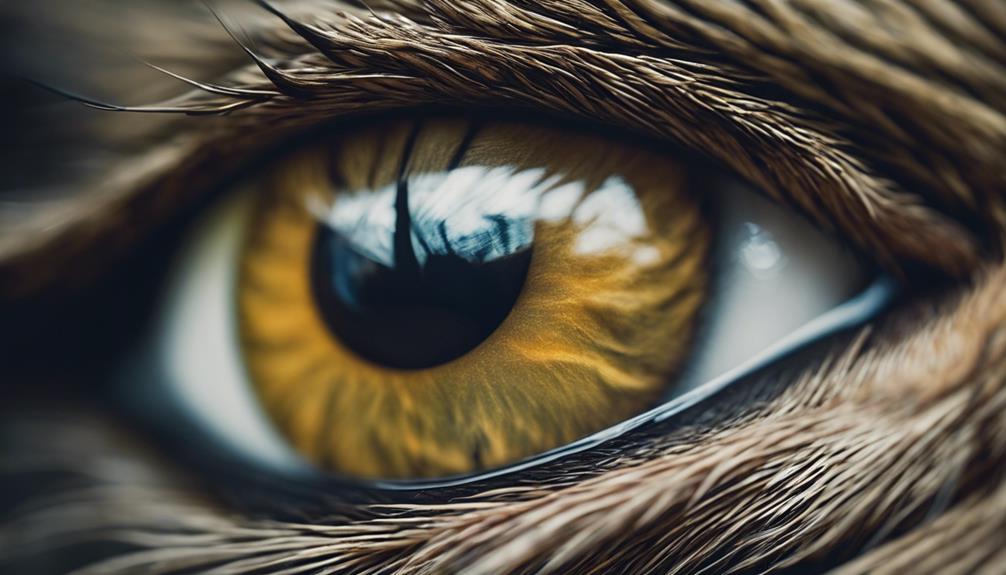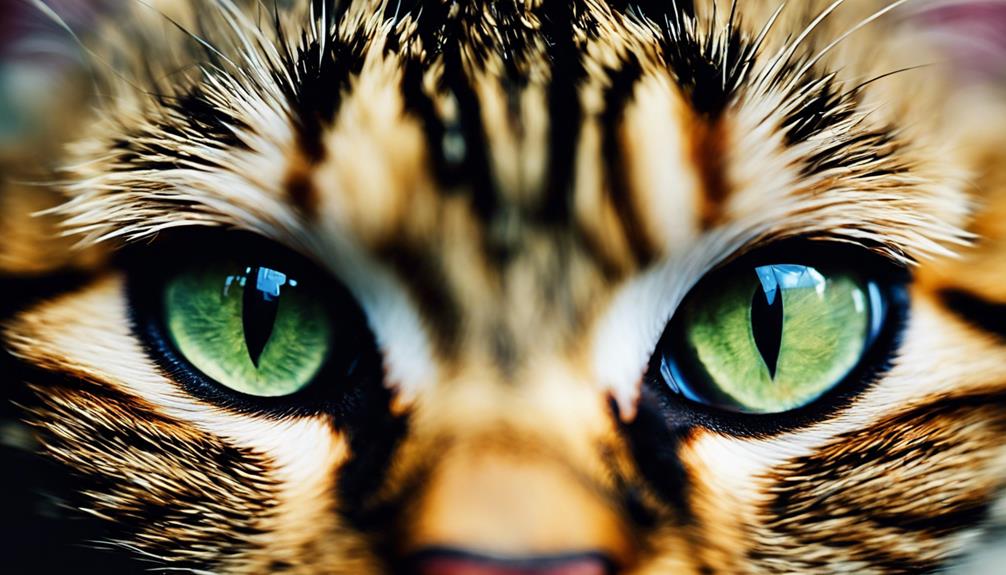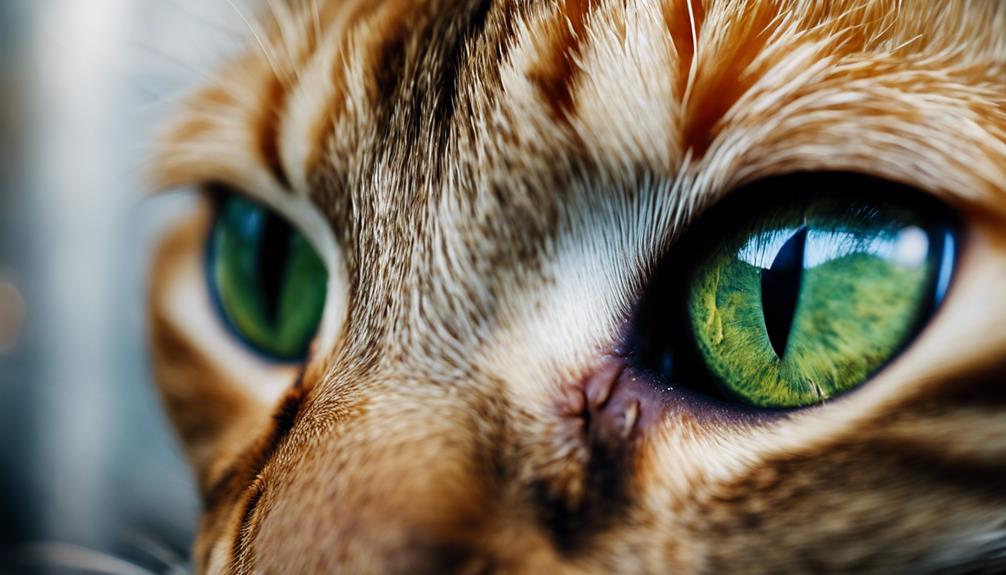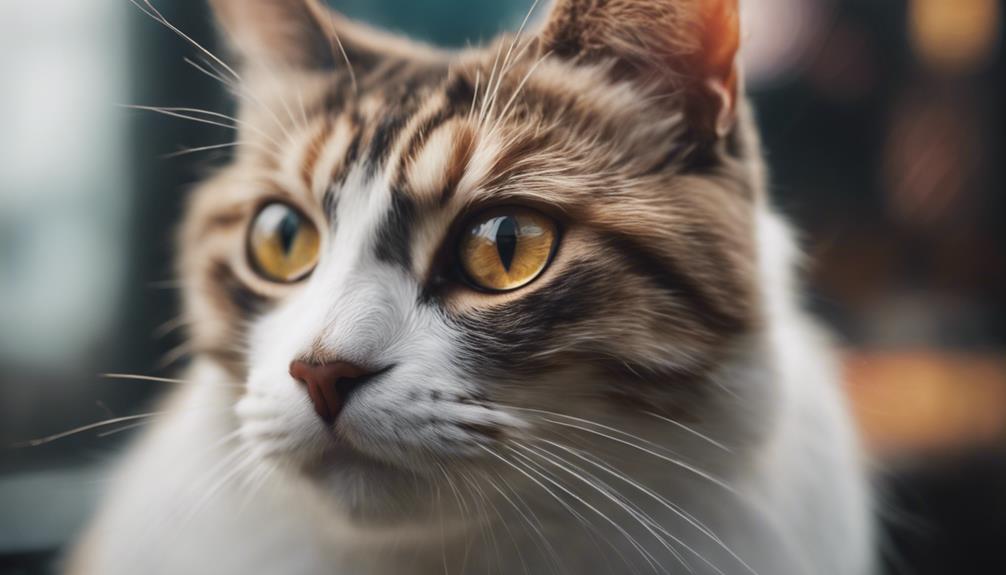Within the intricate realm of feline ocular anatomy, the third eyelid of cats stands as a unique and essential feature that warrants insightful exploration. This specialized membrane serves a pivotal role in safeguarding the ocular health of our feline companions, yet its nuances often remain shrouded in mystery.
By unraveling the complexities surrounding cats' third eyelid, a deeper understanding of its functionality and potential implications emerges, shedding light on the intricate interplay of evolution and adaptation within our feline friends' eyes.
Key Takeaways
- Cats' third eyelid serves a protective function, aiding in keeping their eyes clear of debris.
- The visibility of a cat's third eyelid can indicate potential medical issues, requiring veterinary attention.
- Redness, swelling, or excessive protrusion of the third eyelid warrant a visit to the vet for evaluation.
- Cats' third eyelid contains a tear-producing gland, contributing to their eye health and maintenance.
Cat Eye Anatomy Overview
In understanding the intricate visual system of cats, an exploration of their unique eye anatomy illuminates the remarkable adaptations that contribute to their hunting prowess and nocturnal abilities.
Cats' elongated pupils enhance depth perception, aiding in accurately judging distances while hunting.
The presence of a tapetum lucidum reflects light within the eye, improving night vision capabilities.
Cats also have more rods and fewer cones in their eyes compared to humans, optimizing their vision in low-light conditions.
Additionally, the shape of a cat's eye plays a crucial role in their hunting efficiency by providing a wide field of view.
These anatomical features collectively equip cats with exceptional visual acuity and sensitivity, essential for their survival in various environments.
Evolutionary Significance of Third Eyelid
The evolutionary development of cats' third eyelid underscores the enduring importance of adaptive anatomical features in feline physiology. This unique ocular structure has evolved over time to meet the specific needs of cats in their environment.
To understand the evolutionary significance of the third eyelid, consider the following:
- Survival: The presence of the third eyelid in cats highlights the crucial role it plays in their survival, aiding in protecting their eyes from potential harm.
- Adaptation: Through evolution, cats have fine-tuned this protective mechanism to suit their hunting and predatory behaviors, showcasing the adaptability of their anatomy.
- Species Resilience: The persistence of the third eyelid in feline anatomy signifies the resilience of species-specific traits that have stood the test of time, contributing to the overall health and well-being of cats.
Protective Function of the Nictitating Membrane

During moments of vulnerability, a cat's nictitating membrane acts as a shield, safeguarding their delicate eyes from potential harm. This thin, translucent third eyelid provides additional protection, helping to keep the eyes moist and free from debris.
Positioned between the cat's lower eyelid and the eye itself, the nictitating membrane can quickly sweep across the cornea, offering a defensive barrier against dust, dirt, and other foreign particles. This protective function is essential for outdoor cats exposed to various environmental elements that could otherwise pose a risk to their ocular health.
The nictitating membrane's swift reflexes and ability to cover the eye contribute significantly to maintaining the cat's vision and overall eye well-being.
Understanding Third Eyelid Visibility
Examining the phenomenon of cats' third eyelid visibility sheds light on crucial indicators of feline ocular health and potential medical concerns. A cat's third eyelid may become visible when they are resting or sedated, offering a glimpse into their eye health. The color of the third eyelid can vary, indicating different states of health.
Cats also have some control over the position of their third eyelid, influencing its visibility. Observing the visibility of the third eyelid can provide valuable insights into a cat's well-being and prompt early detection of any underlying medical issues. Paying attention to this subtle indicator can aid in maintaining your feline companion's optimal eye health.
Signs of Third Eyelid Related Concerns

Observing your cat's behavior can reveal subtle signs of potential third eyelid related concerns. If you notice increased visibility of the third eyelid, redness, or swelling, it may indicate an underlying issue.
Cats may also paw at their eyes, squint, or show signs of discomfort when their third eyelid is affected. Excessive blinking, tearing, or avoiding bright light could be additional indicators of a problem.
Any changes in the appearance or behavior of your cat concerning their eyes should prompt a visit to the veterinarian. Addressing these signs promptly is crucial to prevent further complications and ensure the well-being of your feline companion.
Regular eye examinations and prompt treatment can help maintain your cat's ocular health.
Eye Infections in Cats
Eye infections in cats can lead to discomfort and potential vision issues if left untreated. These infections can be caused by various factors, including bacteria, viruses, or fungi. It is crucial for cat owners to be vigilant and seek veterinary care if they suspect their feline companion has an eye infection.
To evoke emotion in the audience, consider the following:
- Helplessness: Imagine your beloved cat in pain, unable to communicate their discomfort.
- Fear: The thought of your cat losing their sight due to an untreated infection can be terrifying.
- Responsibility: As a pet owner, ensuring your cat receives timely medical attention is a crucial part of caring for their well-being.
Common Cat Eye Problems

One of the most prevalent issues affecting cats' ocular health involves a range of common eye problems that can impact their overall well-being. Cats are prone to various eye conditions such as corneal ulceration and conjunctivitis. Corneal ulceration, which is a scratch or erosion on the cornea, can lead to pain, squinting, and excessive tearing.
Conjunctivitis, characterized by redness and inflammation of the conjunctiva, may result from infections, allergies, or other irritants. Additionally, cats may experience issues like watery eyes, eye discharge, cloudiness in the eye, or changes in the appearance of the pupils. These common eye problems in cats necessitate prompt veterinary attention to prevent complications and ensure optimal eye health.
Administering Eye Drops to Cats
Administering eye drops to cats requires a gentle and precise approach to ensure effective treatment and minimal stress for the feline patient. To make this process as smooth as possible, consider the following tips:
- Create a Calm Environment: Choose a quiet space free from distractions to help your cat feel at ease during the application of eye drops.
- Use Treat Rewards: Reward your cat with treats and praise after administering the eye drops to associate the experience with positivity.
- Handle with Care: Gently hold your cat's head steady and avoid sudden movements to prevent any discomfort or injury during the process.
Cherry Eye in Dogs Vs. Cats

When comparing the occurrence of cherry eye between dogs and cats, there are distinct anatomical and predispositional differences to consider. Cherry eye, a condition where the gland of the third eyelid prolapses and becomes visible, is more commonly seen in dogs, particularly certain breeds like Bulldogs, Beagles, and Cocker Spaniels.
In cats, cherry eye is a rare condition compared to dogs. The anatomical structure of the third eyelid in cats differs from that of dogs, potentially contributing to this discrepancy. Cats have a more developed and robust gland of the third eyelid, which may be why cherry eye is less prevalent in felines.
Understanding these variations is crucial for veterinarians to provide appropriate care for affected animals.
Frequently Asked Questions
Can Cats Control the Movement of Their Third Eyelid, or Does It Move Independently?
Cats have partial control over their third eyelid's movement. While it can move independently to protect the eye, cats can also voluntarily retract or partially expose it. Excessive visibility or prolonged protrusion may signal a veterinary concern.
Are There Any Specific Breeds of Cats That Are More Prone to Third Eyelid Issues?
Certain cat breeds like Siamese, Burmese, and Oriental cats are more prone to third eyelid issues due to genetics. Regular veterinary check-ups and prompt attention to any changes in the third eyelid's appearance are crucial for early detection and treatment.
How Does the Third Eyelid Contribute to a Cat's Overall Eye Health and Vision?
The third eyelid in cats contributes significantly to their overall eye health and vision by providing protection against debris, harboring a tear-producing gland, and indicating potential medical issues when protruded, underscoring its vital role in feline ocular well-being.
Are There Any Preventative Measures That Cat Owners Can Take to Reduce the Risk of Third Eyelid-Related Problems?
To reduce the risk of third eyelid-related problems in cats, owners can maintain regular eye care routines, monitor for any signs of redness or swelling, keep the environment clean to minimize debris, and promptly seek veterinary attention for any concerning changes.
Can Cats Experience Discomfort or Pain When Their Third Eyelid Is Showing More Than Usual?
Cats may experience discomfort or pain when their third eyelid is unusually visible, potentially indicating underlying eye issues. Redness, swelling, or excessive visibility should prompt a veterinary evaluation to address any medical concerns promptly and appropriately.
Can Toxoplasmosis Affect a Cat’s Third Eyelid?
Toxoplasmosis, caused by the feline parasite toxoplasmosis, can affect a cat’s third eyelid. This common protozoan infection can cause inflammation and protrusion of the third eyelid, leading to discomfort for the cat. Understanding the facts about feline parasite toxoplasmosis is crucial for preventing and managing this condition.
Conclusion
In conclusion, the third eyelid of cats plays a vital role in protecting their eyes and is a fascinating aspect of feline anatomy.
Understanding the evolutionary significance and function of this nictitating membrane is crucial for maintaining optimal eye health in cats.
By recognizing signs of third eyelid related concerns and addressing common eye problems, veterinary professionals and pet owners can ensure the well-being of their feline companions' visual health.




